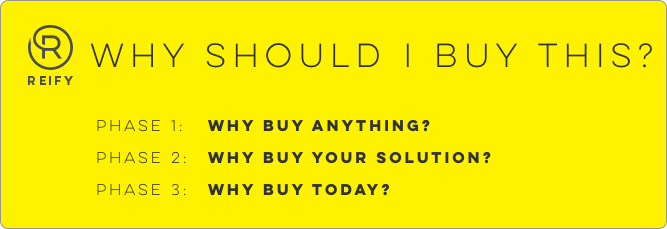When you’ve built something you love, you want to tell everyone about it. This is a great instinct! After all, marketing is more important than code in the adoption of software. An easy mistake to make, however, is telling people what you built, not why they should buy it.
Sharing technical details on how something works, the rationale of certain decisions, and listing a litany of various features does not make for a very compelling marketing message. While that content may be interesting to some folks, they’re left with an important question unanswered - “So what?”.
The remedy to “So what?”

Trenton Truitt gave a great talk at Heavybit about managing enterprise sales. In this talk he lays out three key phases that you need to overcome when landing a deal. Wether you’re working an enterprise deal, or improving conversion of a self-service SaaS pipeline, your messaging and marketing collateral need to help prospective customers answer these key questions.
Why buy anything?
The first challenge you face when convincing a customer to buy your product, is convincing them to buy anything at all. Your primary competition is not a competitive product, it’s apathy, email, or even a spreadsheet.
To convince someone why they should bother paying money for a solution to a problem, you need to demonstrate the specific value your product delivers, and how that benefits their business.
Focus on customer benefits over product features.
Why buy your solution?
OK, you’ve convinced folks that paying money for a solution to a problem is worthwhile. Along the way, they may start to realize you’re not the only solution to this problem. Why should they pick you?
Focus on what makes you different, to demonstrate why you’re better for a particular set of customers.
What makes you different? Is it your domain experience? Do you have a novel approach? Do you have a substantially better developer experience? Do you have a more compelling pricing model? Do you integrate well with other prominent tools? There are lots of ways you might be different from the competition, which should be forming key portions of your messaging framework already.
Why buy now?
This is the hardest step! You may convince someone to buy something, and they may decide your solution is best, but they’re just not motivated to make that purchase today.
Quantify the negative value of not buying today
Once you’ve clearly demonstrated the value and positive ROI your product delivers, we can focus on quantifying the loss of that benefit to provide justification and urgency to the buying cycle.
For example, if your solution helps save developers 1h per day of programming effort, and the average team size in your market is 25 developers, you might say that you are saving a company 175h per week, which costs a company over $50k per month in lost developer productivity. Think about ways you can quantify the value of lost productivity, or lost deals, or team happiness, etc. that may provide the context and urgency necessary to motivate someone to buy today.
Need help?
This can all seem daunting, but developing messaging and marketing collateral that helps prospective customers understand the benefits of your product is essential to its growth. Drop us a line if you’d like some help!
